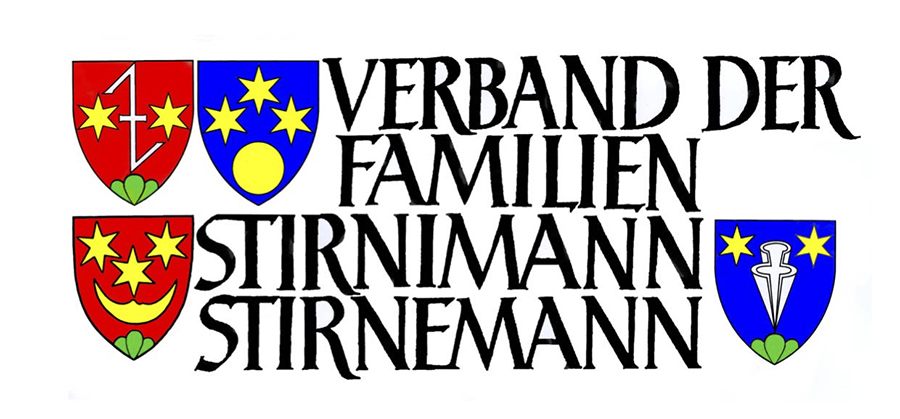

Newsletter No. 26 Ruswil - March 2000
Table of Contents
Foreword 1
The religious women of the Stirnimann family 2
The seal of the Stirnimann family in Ruswil 7
Minutes of the 10th family conference, Gränichen AG 8
Forum 10
Miscellaneous 12
Dear relatives and friends
Dear members and friends of our family association.
"What is the real extent of what seemed long to some and short to others?" With this thought from the French poet Sully Prudhomme (1839-1907) I would like to greet you all in the New Year. Time, although measurable in different sizes, will always have an emotional, psychological dimension.
Don't you sometimes feel the same way as me: There is a week in which you start work on Monday. And is Thursday or Friday already on the calendar sheet again? And how darned, a week later you think Monday just doesn't want to end? Probably every person will experience such "time fluctuations" throughout their life. There will certainly be many people who, fearful of the possibility of "losing" time, want to fill the given time with as many activities as possible; others, on the other hand, may say to themselves "what's the point" and don't take the course of events too seriously. Well, I think that it is important not to get grumpy with this individual sense of time, but rather to respect the given time as a valuable gift that needs to be filled sensibly and consciously. If we can do this, we will be determined to be satisfied and, I am firmly convinced, can also go through the new century as peaceful people.
Taking our time and looking after the association, two things that we were able to put into practice again last year at our family conference in Gränichen. The successful conference in Gränichen offered the opportunity to experience and refresh encounters and acquaintances. You can find everything about the anniversary conference, dear association members, in the minutes published in this circular.
We also had to fill our time with painful duties. Ours died on October 21, 1999 Former board member Hans StirnimannHelfenstein, community clerk and notary of Neuenkirch, at the age of 52. On behalf of the association, we extend our condolences to the bereaved family.
The future of our family association has long been a major concern of the board. We want to approach the future with many, sometimes only small steps. A first step has already been taken with the opening of a forum page in the newsletter, which, by the way, is open to all association members (free of charge). Our association has recently been "online" and has a website on the Internet. We are currently also looking for a new type of conference so that we can increasingly address the younger generation again. Thinking and working on the board would be pointless if you, dear association members, were absent. Only with your support, which we always have, do we feel strengthened and on the right track, and
I thank you very much for that. May we fill our time in the spirit in which our association was founded on September 8th, 1974. So I wish you a lot of time, time that is sensibly and satisfactorily filled!
With best regards
The President Beat Stirnimann
II. The nuns of the Stirnimann family
The right of the Catholic Church to understand religious orders as monastic associations, the members of which take solemn vows of obedience, chastity and poverty. The Benedictines and Cistercians are among the oldest orders. As in the enumeration of the religious in our family in the last newsletter, the term religious woman is to be understood in the broadest sense. Sisters of old orders such as Cistercians and Dominicans are the exceptions, most of the sisters belonged to communities of modern times, so they are not religious women or sisters in the original sense.
The Cistercian Abbey Rathausen near Lucerne, founded in 1245, was abolished on April 13, 1848 by the Grand Council of the Canton of Lucerne (as was the respected Cistercian Abbey of St. Urban). This arbitrary act was justified with the expenses and debts caused to the state by the Sonderbund war. The 15 sisters from Rathausen initially found accommodation in the Cistercian Abbey of Eschenbach, only a few kilometers away. On July 13, 1855, the sisters were able to rent the former Capuchin monastery of St. Joseph in Schwyz. In 1876 they acquired the former Capuchin monastery of St. Joseph in Wzelise in Lorraine, until they were expelled from France as a result of the French association law of 1901. As early as March 11, 1902, the sisters acquired the former prince-bishop's hunting lodge in Thyrnau near Passau, which was surrounded by land and which subsequently became the St. Joseph Monastery
of the former women's convent Rathausen took over and continues to this day with success.
Sr. Maria Ursula Stirnimann saw the light of day in Hinteretzenerlen in Ruswil. Century until today one of the largest farms of our family. She was the eldest of the eight children (3 sons and 5 daughters) of the married couple Matthias Franz Joseph Stirnimann and Katharina Meyer and was baptized on December 9, 1801 in the parish church in Ruswil under the name Maria Katharina. The father had inherited the 79.5 Jucharten farm from his father Matthias Stirnimann. The files and information about the novice and nun Maria Ursula Stirnimann are very sparse, as is the case with most of the sisters of the Rathausen Abbey. In a letter dated March 21, 1827 in the monastery archives in Thyrnau, the father Matthias Stirnimann obliged his sons and daughters that their sister would be guaranteed a capital of 100 guilders for lifelong usufruct when they entered the monastery, but that this amount would continue until the death of the religious will be returned to the legal heirs.
In a division between the brothers Matthias and Johann Stirnimann von Etzenerlen on March 6, 1850, a validity transferred to the Rathausen monastery on February 25, 1817 becomes Value of 570 guilders mentioned. The novice from Ruswil chose or received the name Ursula. Fortunately, her handwritten declaration of profession has been preserved in the archives of Thymau Abbey. The sister archivist was kind enough to send us a photocopy. The following is the text of the profession:
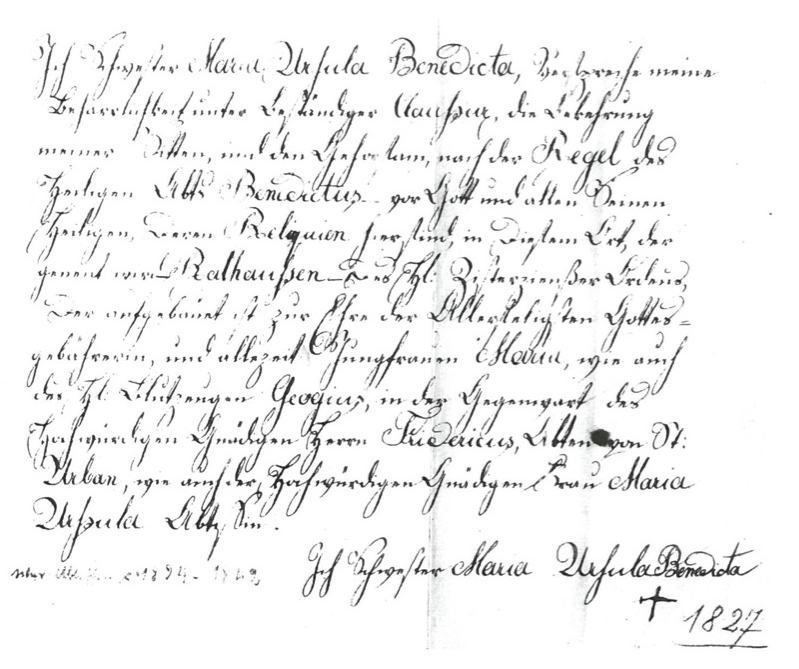
2. Mother M. Vincentia Stirnimann (1828-1895), prioress of the Dominican convent St. Peter am Bach, Schwyz
Sr. Maria Vincentia Stirnimann (her baptismal name: Maria Elisabeth) was born on October 28, 1828 on the Landsberg farm in Ohmstal.
She was the third of the five children and the only daughter of Joseph Anton Stirnimann, who moved from Ruswil, and his first wife Maria Frey (dated March 1, 1835). Joseph Anton Stirnimann had 15 children from his second wife Maria Josepha Kneubühler. Adam Stirnimann (1755-1822), the father of Joseph Anton Stirnimann, bought the Landsberg farm, one of the largest farms in the area, in 1818. Joseph Anton, the eldest of his three sons, taught the children of the Ohmstaler Comprehensive School, presumably during the winter months. He was also a poor carer, community president and church councilor. In 1842 he bought the Riedbruggmühle in Ettiswil for CHF 65,333, with 112 Jucharten land and 8 Jucharten forest. Joseph Anton Stirnimann died on June 8, 1868.
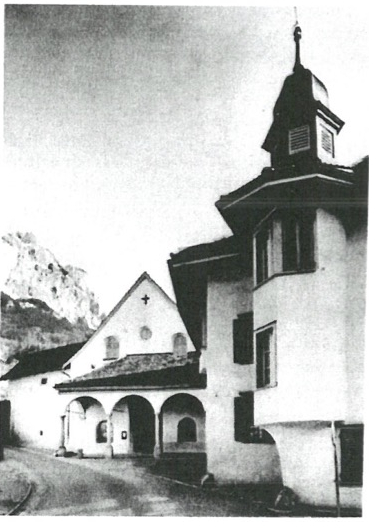
Dominican convent of St. Peter, Schwyz
Many thanks to the Dominicans in St. Peter in Schwyz for their valuable information. - Please also note the explanations about "The Stirnimann family from Ohmstal" in the circular "Verband der Stirnimann families", No. 5, Ruswil, April / May 1979, pp. 3-7.
The most important personality of the family was the only daughter of Joseph Anton mentioned above: Maria Elisabeth, who entered the Maria Hilf monastery in Lucerne and thus the order of the Ursulines at a young age. Her religious name was Ignatia. When the Maria Hilf monastery was closed in 1847, Sr. Ignatia and two sisters moved to Schwyz. The three Ursulines lived in the Dominican convent and gave school lessons in Schwyz for five years. Then Sr. Ignatia and one of her two sisters who had moved to Schwyz asked for admission to the monastery and to join the order of the Dominican Sisters. The two made their profession on November 9, 1853. Sr. Ignatia called herself Maria Vincentia. She was appointed teacher to the postulants and later a conductress. She was also a gifted organist and an accomplished embroiderer. In 1863 they elected the sisters as their prioress for the first time. After this first term of office she was novice master and subprioress and prioress again from 1876 to 1885, then a conductress for three years. From 1888 until her death in 1895, Sr. Vincentia once again presided over the monastery as the capable and widely appreciated prioress.
3. Sr. M. Clara Stirnimann (1883-1904), sister of Divine Providence, Baldegg Monastery
Sr. Maria Clara was born on July 19, 1853 in Ruswil on the Hinter Loch farm and was baptized Barbara on the same day in the Ruswil parish church. She was the tenth of the 16 children (7 sons and 9 daughters) of the married couple Adam Joseph Stirnimann (1811-1881) and Elisabeth Lisibach. On June 13, 1863 Adam Joseph Stirnimann exchanged the Hinter Loch farm he had acquired in 1847 for the one in the Vorder Loch. But in the same year (December 3, 1863) he sold this property with the pretty Lucerne farmhouse again and acquired the magnificent Ober-Merzenberg farm, high above Nottwil, with 99 Jucharten. We know them reasons for this purchase: Joseph Fischer-Heini, the farmer in the Upper Merzenberg, was a cousin of Elisabeth Lisibach, the wife of Adam Joseph Stirnimann, he was seventy and of blindness, all of his children had died at a young age.
The daughter Barbara was just ten years old when the family found their new home in Upper Merzenberg. The date of her entry into Baldegg Monastery is not known. She made her profession in 1881 and was given the name Clara. She found her first job in the Oberkirch community home or poor house in the canton of Lucerne. Then Sr. Clara worked as superior in the Hitzkirch teachers' college until her death. The nun, much appreciated for her kindness, died on February 26, 1904 at the age of only 49 in the 23rd year of her profession.
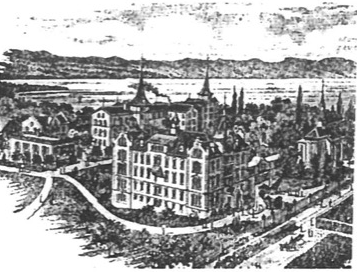
Baldegg around 1830
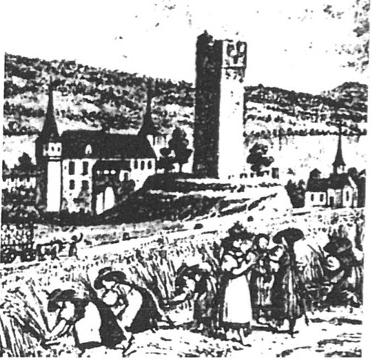
Baldegg around 1903
4. Sr. M. Maura Stirnimann (1874-1962), Sister of Divine Providence, Baldegg Monastery
Maria Josepha was born as the last of the six children of the married couple Johann Stirnimann and Maria Wandeler on August 14, 1874 on the Voglisberg farm in Neuenkirch and was baptized on August 16, 1874 in the local parish church. The parents died early. Maria Josepha Stirnimann was admitted to the novitiate on September 13, 1903 at Baldegg Abbey under the name Maria Maura. She made her profession on September 20, 1904. Sr. Maura was first in the Klotensberg community center and the Eintracht workers' home in Hochdorf, from 1909 to the end of 1956 she was employed in the Altishofen community center, and from 1933 to 1956 as superior. Since December 1956 she was in the hospital ward of the mother house, where she died on September 23, 1962. Sr. Maura was a true mother to the poor and elderly in the community centers. "Better too good than too strict," was their principle.
5. Sr. M. Clara Stirnimann (1883-1961), Sister of Divine Providence, Baldegg Monastery (niece of No. 3)
Katharina Elisabeth, born on December 6, 1883 in the Upper Bernern in Nottwil and baptized on the same day in the parish church in Nottwil, was the first of nine children of the married couple Kaspar Stirnimann and Maria Katharina Huber. Katharina entered Baldegg as a candidate on August 5, 1905, on August 12, 1906, she began her novitiate under the name Clara, and on September 26, 1907, she made her profession. As the sister of Divine Providence, she served the sick and needy people in the Kolping House in Zurich, in the St. Josephsheim Susten, in the Lucerne day nursery, in the community home in Muri, in the Hertenstein Institute and in between in various houses as a temporary worker, from autumn 1926 to November 1957 Gunzwil community center. Sr. Clara spent her last two years suffering in the mother house, where she passed away blissfully in the Lord on December 31, 1961.
6. Sr. M. Micheline Stirnimann (1893-1972), Sister of Divine Providence, Baldegg Monastery (sister of No. 5)
Elisabeth, the sixth child of the married couple Kaspar Stirnimann and Maria Katharina Huber, was born on July 12, 1893 in the Upper Bernern in Nottwil and was baptized on July 14 in the local parish church. Elisabeth began her novitiate in Baldegg Monastery on August 24, 1919 under the name Micheline. She made her profession on August 31, 1920. The self-sacrificing sister first served the sick in the hospital in Brig and acquired the diploma of a nurse, above all with the intention of putting her energies into the service of the mission in Africa, where the Baldegger sisters took on the missionary task in Tanganyika in 1921 had. In 1922 he was sent to the Africa Mission. Sr. Micheline worked mainly as a gardener, first in Kwiro, Jfakara and Kipatimu, then for 14 years in Msimbazi. After 28 years, Sr. Micheline came home for her first vacation, but never returned to Africa. She began her new "missionary work" at home in the service of the sick fellow sisters, in 1951 in Marienheim Hochdorf, 1961 in Mümliswil, 1962 in Flüeli, 1964 in the Turmmattli in Samen, most recently in the motherhouse in Baldegg, where on September 17, 1972, after a passed away in an exemplary and fulfilling life in the Lord
7. Sr. Clothilde Stirnimann (1861-1939), Institute of the Sisters of the Holy Cross, Menzingen
Maria Barbara, as she was called since her baptism on February 1st, 1861 in the parish church of Ruswil, born as the only daughter of the married couple Joseph Matthias Xaver Stirnimann and Jakobea Studer on the Buchmatt home in Ruswil, which borders the Saalhof. It should be remembered that Sr. M. Ursula Stirnimann (1801-1844) in the Cistercian Abbey of Rathausen (the first of the religious women presented in this newsletter) was an aunt of Sr. Clothilde. Perhaps the role model and example of the aunt in the Rathausen monastery motivated the niece in Buchmatt to also become a nun. But the hopeful, young Congregation of the Sisters of the Holy Cross was obviously closer and more familiar to her than an old convent.
The talented farmer's daughter made her profession in 1880 as Sr. Clothilde. She became a teacher and as such a pioneer of the branches of the Menzing teaching sisters founded in the canton of Friborg. Sr. Clothilde worked in the schools in Neyruz, later in Cottens, Ependes and Farvagny. Afterwards she went to the girls' school in Avry-devant-Pont, where she was also the manager of the poor house. She held this post for 35 years. The obituaries portray Sr. Clothilde as a capable, skilful teacher, a servant, selfless matron and a masterful embroiderer. Sr. Clothilde died on December 14, 1939.
Obituary in "Greetings from the motherhouse", Menzingen, No. 58, May 1940, p.73 f.
Joseph Stirnimann
To be continued and concluded in the next newsletter
The seal of the Stirnimann family in Ruswil
The handwritten book of arms of the famous heraldist Georg von Vivis (1858-1929) kept in the central library in Lucerne shows the seal of the Stirnimann von Ruswil depicted here on page 135. Unfortunately, the seal can no longer be found in the seal collection IV A 2s Luzern / Ruswi 1 mentioned in the manual. Our first attention goes to the cross in the lower left half of the seal. This is the original coat of arms of the municipality of Ruswil, namely the white cross on a red background. This original Ruswil coat of arms has recently been replaced by the image of St. Mauritius, the patron of the parish and parish Ruswil.
And what do the wavy lines in the lower right half of the seal mean? Probably nothing more than the stream or river that flows through the courtyard in the Rot in the municipality of Ruswil. The wavy lines can also be the symbol of the courtyard in Rot. We will deal with the two towers in the upper half of the seal later.
The progenitors of the Stirnimann von Ruswil
In 1610/1611, Peter Stirnimann and his wife Adelheid Bircher and their three sons Hans, Peter and Hans-Jakob von Luthern moved to the large farm in the Rot in Ruswil. After the eldest son Hans died, presumably in 1647, the third son Hans-Jakob took over the 160 Jucharten farm in the Rot. The second son named Peter married Maria Süess in 1624, the heiress of the neighboring 170 Jucharten farm Etzenerlen court. Peter Stirnimann consequently became a farmer in Etzenerlen through marriage and soon took a leading position in Twing Ruswil. So he was a judge and as such the chairman of the village court. This large farmer, whose marriage remained childless, made a name for himself above all for his social ethos and charity. So he gave the donation, which was incumbent on the poor, 1000 guilders. He donated the same amount to the Ruswil parish church for a perpetual year-long foundation for himself, his wife, his parents and "everyone who is of the same family". This year was the most generous donation that was ever built in Ruswil. A thousand guilders of that time are at least two hundred thousand Swiss francs based on today's value. Peter Stirnimann and his wife were also godparents of many children of homeless parents and illegitimate relationships.
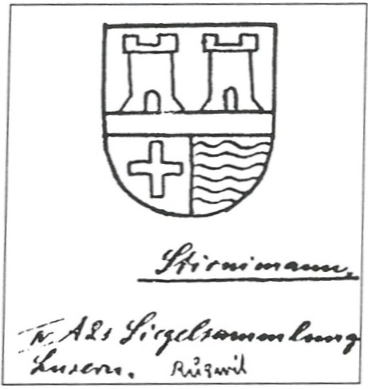
The Heirs
Peter Stirnimann died on January 8, 1668 at the age of 68. His brother Hans-Jakob took over the farm as the only heir. This was an inheritance from the Canons' Monastery of St. Michael in Beromünster, which in the event of a change of ownership demanded the treasury of honor, which was a kind of transfer fee, from the new owner under current law. However, Hans-Jakob Stirnimann refused to honor the monastery on the grounds that this was never demanded in the Ruswil office in cases of death or inheritance, this demand of the monastery was an innovation for the entire Ruswil office and affected not only him but also other comrades in office . For his refusal, Hans-Jakob Stirnimann found the full support of the official woman and the Kirchmeier. The pen drew the dispute to the Lucerne authorities. This ruled the case with a judgment of April 17, 1670 in the sense that the honor treasure was basically also due in death and inheritance cases, but with a reduced amount required. Whether the Lucerne authorities decided the dispute alone or with the Beromünster Abbey, or whether the heir and the Abbey reached an agreement - these questions remain open, because the relevant document has been lost. We have every reason to assume that the certificate was provided with the seal of Stirnimann mentioned.
The Two Towers
Based on what has been said so far, an interpretation or explanation of the two towers in the upper half of the seal is also possible. The two towers mean or symbolize the two farms of the Rot and Etzenerlen. The idea of these two farms through two towers to indicate, may have been caused by the two medieval castles that stood in the area of the courtyards Rot and Etzenerlen and of which there were probably still considerable ruins at that time, which were probably used here as well as elsewhere to build houses and barns. The memory of the former castle below Etzenerlen lives on to this day in the field name Burst, which means something like Burgstall or Burgstelle. To the former Grisenegg, whose former owners were very likely the Freiherren von Wolhusen, is reminiscent of the homestead of the same name not far from farm Rot, which Peter Stirnimann (t1620) and his son Hans (t1647) acquired from Jakob Steiner from the parish of Emmen in 1612.
Of the three sons of Hans-Jakob Stirnimann, Sebastian (t 1679), the eldest, took over the Etzenerlen farm, Hans (t1675) stayed in the Rot, Peter (t1706), the third son, became a monk with the name Jost (Jodok) the Benedictine Abbey of Muri in Freiamt in Aargau (he was mentioned in detail in the last circular). Over time, the Etzenerlen farm, which was divided into several properties, is still owned by the descendants of the progenitor Hans-Jakob Stirnimann.
The original farm in the Rot was divided into the two farms, Lower and Upper Rot over time. The Lower Rot farm was sold by Kaspar Stirnimann in 1821.
Joseph Stirnimann
10th family conference in 5722 Gränichen AG
Sunday June 6th 1999
Minutes of the General Assembly
Our President Beat Stirnimann greets everyone present. By holding today's family conference in Gränichen, we want to testify to the solidarity with the home of the name bearers, "Stirnemann". He opened the conference with the adage "Joy is only full when you share it, when you can give it as a gift". Again a large number of association members from near and far responded to the call to meet in the family association. There are 67 adults and 3 children present.
We especially greet Georges Stirnemann, from Colmar, France and Jean and Genevieve Lippens-Stirnimann from Cannes.
He can also specifically welcome the honorary members Heidi Stirnimann, Stans, and Josef Stirnimann-Haas (former President).
Hans Stirnimann-Haupt, Ruswil (Honorary President), Auditor Toni Stirnimann Lucerne and others apologized. Unfortunately, our Vice President Prof. Dr. Joseph Stirnimann, Lucerne, canceled this conference due to age-related reasons. We regret this very much, as he is the author of the publication "The Stirnimann Family in the Cantons of Lucerne and Aargau" and the initiator of the foundation of our association.
The vote counters are Hans Stirnimann Rus-wil and Kurt Stirnimann-Rast. In his return looking back over the past 3 years since the last family meeting, the President describes the activities of the Board of Directors. The main activities were the publication of the newsletter and the recruitment of members (300 members today) and the organization of today's conference. In particular, the editing and creation of the circular is always a main item on the agenda, from Prof Joseph Stimimann, who provides us with the content, to Franz Stirnimann, who professionally edits and prints the circular for us.
After the resignation of our long-time treasurer Alois Stirnimann, Wolhusen, we were able to find a capable successor in the person of Gregor Stimimann, Nottwil, who keeps our accounting (via computer) in good shape.
On the occasion of our conference today, the board decided to make a monetary donation (CHF 1'0004 for the renovation of the church in Storbeck (formerly GDR). The warm words of thanks from Storbeck are a testament to our great joy.
Joy and sorrow are faithful companions of our life. We regret the passing of our board member Othmar Stirnemann, Sempach, (autumn 1997) and our honorary member Franz Stirnimann, Basel (February 1999). The latter has given our association extremely generous support.
Finally, the president looks ahead to the future: our association, founded in 1974, is about to enter the new millennium. Today's family conference in Gränichen is the last of this millennium. The new media such as computers and the Internet enable new forms of family research. Computer genealogy research has become very popular in America. Our association will also orient itself towards this, as we already have some computer experts on the board.
But our most important goal is of course the members of our association who support us to adapt our association to the new times.
2. Minutes of the 9th family conference 1996 in Kaysersberg (Alsace)
Everybody accepted the protocoll.
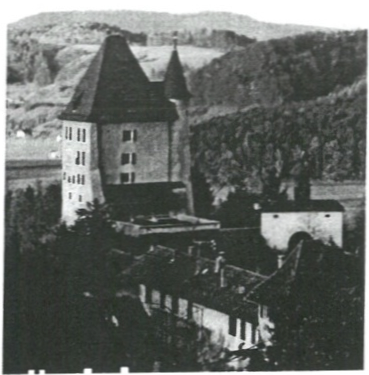
3. Cash report
According to the treasurer's report, the association's assets had grown to CHF 31,646 as of December 31, 1998. This is mainly thanks to generous donations. The cash report and the auditor's report are approved. Decharge is given to the treasurer Gregor Stirnimann, Nottwil, and thanks are due for the accurate bookkeeping.
4. Elections
All previous board members are available again and will be elected in globo. These are:
Beat Stirnimann, Ruswil (President)
Prof. Dr. J. Stirnimann Lucerne (Vice President) Gregor Stirnimann-Lisebach, Nottwil (Treasurer) Josef Stirnimann-Tura, Cham (actuary)
Maria Stirnimans-Schenkermayr, Ruswil Philomena Bartholdi-Stirnimann, Zug
Franz Stirnimann-Bühlmann, Lucerne
Fritz Stirnemann, Zurich
The two auditors are also re-elected. They are:
Josef Stirnemann, Adliswil
Toni Stirnimann Lucerne (absent).
5. Miscellaneous
Honors
The board of directors' proposal to appoint former treasurer Alois Stirnimann-Zihlmann, Wolhusen, as an honorary member is approved by the meeting. This in recognition of his 14 years as treasurer and member of the board. Alois was also always very active in recruiting members.
Requests to speak
From the audience it is mentioned that the present Walter Stirnimann, Neuenkirch, is 60th anniversary of musicians can celebrate.
At the end of the meeting, the President Beat Stirnimann thanks all conference participants, as well as the host couple Stirnemann-Burri for the meal, Max Stirnemann, Gränichen, for his slide show, and the musician Mr. Kaspar, Gränichen.
The President closes the official part of the meeting at 11.45 a.m. The banquet dinner will then take place in the same room. In the afternoon there will be a slide show about Gränichen, "the most beautiful village in Aargau”.
The recorder: Josef Stirnimann-Tura
The grandparents of our namesake Walter Sternemen emigrated to the USA at the beginning of the last century. Here he describes the individual stages of this then very risky emigration as follows: “According to the marriage certificate, my grandfather, Hans Cäsar Stirnimann, was born on November 20th, 1889 in Daro in Ticino. He was the son of Jakob and Marie Louise Stirnimann-Moser. Jackob, descended from a Ruswil family, was born in Neuenkirch and died at the early age of 46. At the time, my grandfather was only 14 years old. According to his youth, he was taken to a monastery with an uncle. He later met my grandmother, Adele Loew. The two decided early on to leave Switzerland to seek their fortune in the New World.
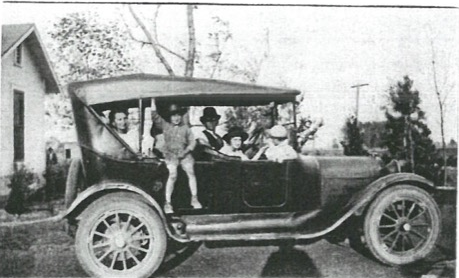
Photo 1925: "Father's brothers - in de USA dehaim”
My grandfather came to the United States for the first time alone in February 1912. History tells us that another Stirnimann family had already settled here near Chicago, Illinois. My grandfather was referred to this family to get help for his start-up phase in the USA (on the passenger list he stated the address of his uncle Fridley as the destination). Upon his arrival, he went to him for the help he expected. However, this was denied to him. From there he went on to Springfield (MO) and was able to take a job as a forest ranger near the Missouri, where he trained as an arborist. In the meantime, in April 1912, the Titanic sank and in June my grandmother came over all alone with her little baby, with no knowledge of English. She went to her husband's in St. Louis. She said she could only utter two things in English, "Milk for Baby" and "Which way to Saint Louis?". This was an eerie journey for a 26 year old woman in a strange land. She also had to go through Ellis Island, the then largest immigration office (transit station for asylum seekers) in the USA, which was feared for its bad treatment. Later we found out that the other branch of the family (ancestry of Stirnemann von Gränichen) was involved in building the national football league. That was the beginning of professional football in America, which has become a very important sport today. At that time this sport was still in its infancy and of little importance. Edward "Dutch" Sternaman and his young brother Joe Sternaman were the famous football players in the 1920's. Eventually they lost their interest in Chicago football and, to my knowledge, later did not engage in the sport.
In 1924 my grandfather Hans and his family moved to Evansville, Indiana, where he worked for a local tree nursery and eventually opened his own business, The John Sternemen Landscaping and Contracting Company. He was given various important projects for the landscape maintenance, so in the Evansville area including Burdette Park, the Washington Grade School, the Reitz and Mater Dei High Schools, the East Side Park and the Christ The King church. According to statements of my cousin Terry Phelps grandmother “painted, made blankets, in her garden worked, sewed for others, baked sweets and ran a bridge club on the side.
Hans and Adele had eight children, all of whom were very successful at work. They all had nice families. The eldest son, John, studied at St. Minred School to become a monk. After meeting Marcella Smith, he decided to leave the monastery. He was a member of the UAW-CIO Leadership Institute. He has also served as an insurance advisor in Stephenville, Texas. Their daughter Margaret married Roy Marx and ran her own restaurant in Evansville. Della married Walter Sirkle and they bought a farm in the Evansville area. Son Joseph took over the landscaping business in Evansville and my father Walter became an industrial engineer and settled in Bloomington, Indiana. Edward owned a gas station in the town of Terre Haute, Indiana. Betty married Robert Kennedy, who worked in the film industry, and moved the family to Tucson, Arizona. The youngest son Robert was a carpenter in Evansville “.
Walt Sterneman
Who can help? Who might know about the ancestors they are looking for?
“My grandfather was Hans Stirnimann. He came to the USA from Basel in 1912. His parents were Jakob Stirnimann, born in Neuenkirch LU in 1857 and Louise Moser, born in Diessbach BE in 1857. He had a brother named Oskar Jakob, born in Stans in 1887, married to Clara Weber in Basel in 1912, their children were Oskar Jakob Stirnimann, born August 19, 1912, married to Elsa Völlmy; Elsa Clara Stirnimann, born 5.1.1914; Felix Rudolf Stirnimann, born May 15, 1916, married to Helene Vögtlin: Werner Bernhard Stirnimann, born November 4, 1920, married to Alice Waeschle "
“Another family is looking for his ancestors from Johann Stirnemann, born December 26th, 1837 in Gränichen and Ann Widmer, born October 23rd, 1842, also from Gränichen. They married in Gränichen in 1865. Her son is Johann, born March 15, 1868 in Gränichen. I myself come from a family in Ruswil, so I don't have any further information about these families. Is there anyone I could get in touch with to find out more? “ Contact address: Walter Sterneman, 4526 Mexico Dr., Fort Wayne, Indiana, USA email: twstern@home.com
Congratulations: Cross of Merit for Heinz Stirnemann, Storbeck
The Märkische Zeitung "Ruppiner Anzeiger" dated March 9th, 2000 we take the following:
STORBECK • Federal President pays tribute to local writers
The local chronicle from Storbeck, Heinz Stirnemann, will be awarded the Federal Cross of Merit on ribbon tomorrow. Brandenburg Minister of Culture Wolfgang Hackel (CDU) carries out the award on behalf of Federal President Johannes Rau.
It was Johannes Rau himself who suggested Heinz Stirnemann for this award, the highest in Germany. On the occasion of the honorary office day on December 6, 99, the services of the almost 83-year-old from Storbeck to the local history and Evangelical Church of the region were to be honored, L said from the office of the Federal President. The award ceremony will take place tomorrow afternoon as part of a ceremony.
Since the beginning of this month we have been present worldwide with our new website at all times. The initiator and creator of the website is our actuary Josef Stirnimann-Tura. He took a lot of time for this and will continue to strive to expand and update the website. You can obtain information about our association at www.stirnimann-stirnemann.ch. Take a look and give us your feedback. Have fun surfing!